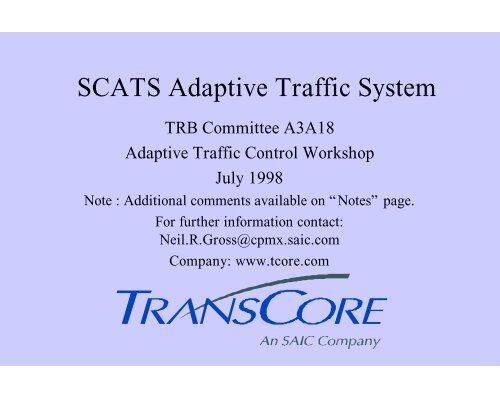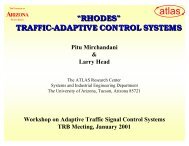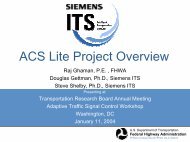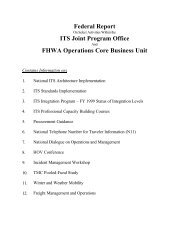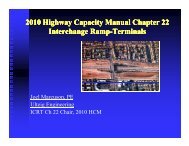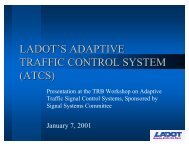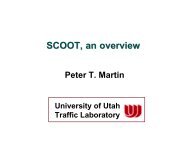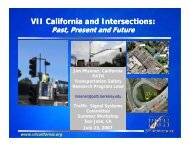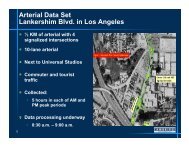SCATS Adaptive Traffic System - Traffic Signal Systems Committee
SCATS Adaptive Traffic System - Traffic Signal Systems Committee
SCATS Adaptive Traffic System - Traffic Signal Systems Committee
You also want an ePaper? Increase the reach of your titles
YUMPU automatically turns print PDFs into web optimized ePapers that Google loves.
<strong>SCATS</strong> <strong>System</strong> ArchitectureExpansion from Single RegionData SwitchDial-inWorkstation(s)Local RegionalComputers<strong>SCATS</strong> <strong>Traffic</strong>ControllersUp to 128 perRegionalComputerPoint-to-Pointconnected <strong>Traffic</strong>ControllersMultidrop connected <strong>Traffic</strong> Controllers4
<strong>SCATS</strong> <strong>System</strong> ArchitectureManagement <strong>System</strong>OperatorWorkstationsDEC VAX<strong>SCATS</strong> Management Computer<strong>SCATS</strong> LANDial-inWorkstation(s)Local RegionalComputers<strong>SCATS</strong> <strong>Traffic</strong>ControllersUp to 128 perRegionalComputerPoint-to-Pointconnected <strong>Traffic</strong>ControllersMultidrop connected <strong>Traffic</strong> Controllers5
<strong>SCATS</strong> <strong>System</strong> ArchitectureRemote Regional ComputersOperatorWorkstationsDEC VAX<strong>SCATS</strong> Management Computer<strong>SCATS</strong> LANDatalinkDial-inWorkstation(s)Up to 32 Regional ComputersLocal RegionalComputersRemote RegionalComputer(s)<strong>SCATS</strong> <strong>Traffic</strong>ControllersUp to 128 perRegionalComputerPoint-to-Pointconnected <strong>Traffic</strong>ControllersRamp MeteringControllersMultidrop connected <strong>Traffic</strong> ControllersMixed Connection6
<strong>SCATS</strong> <strong>System</strong> Architecture• Local <strong>Traffic</strong> Controllers - tactical control (calling,extension) and data collection,• Regional Computers - Strategic control,• Management Computer - Communications and Databasefunctions.• Simplest configuration - single Regional Computer.• Operator Interface - Windows 95 or -NT Graphical userinterface with point and click access to all parameters.8
<strong>SCATS</strong> GUI Example9
<strong>SCATS</strong> Data Requirements• Loop Detectors or equivalent (video detection inOakland County MI) in each lane at the stop line.• Detectors used for calling and extension.• Controller collects number of spaces and totalspace time during green of each phase, each cyclefor use by <strong>SCATS</strong> adaptive algorithm.• Actual movement data collected by stop linedetectors allows accurate split determination.10
<strong>SCATS</strong> Data Requirements• Degree of Saturation (DS)and Car Equivalent Flow(VK) for each Approachlane .• DS used to vote for CycleLength and Split Plan.• VK used to vote for OffsetPlan11
<strong>SCATS</strong> Data Requirements• No modeling required.• User defines:– subsystems– target cycle lengths and relationship to DS,– split plan strategy– linkages and offsets13
<strong>SCATS</strong> Communication Requirements• Point-to-Point orMultidrop.• Once per secondcommunication with eachintersection.• Messages are normally 1to 5 bytes, average 3bytes.RegionalComputerMultidropPoint-to-Point300 Baud, Bell 103 FSKFull Duplex two-wire.Standard "telephone" pair.(~4KHzbandwidth).1200/2400 Bps, V22/V22bisDPSK/QAM Full Duplex two-wire.Standard "telephone" pair (~4KHzbandwidth).4 or 8 drops.14
<strong>SCATS</strong> Communication Requirements• Optional digitalcommunications port(RS232) for directnetwork connection,• Requires 300 Baud Fullduplex channel withaddressing/routing bynetwork.<strong>SCATS</strong> Regional <strong>System</strong>ANetworkBDigital (RS232)AB15
<strong>SCATS</strong> <strong>Traffic</strong> Controllers170 NEMA• AWA Delta 170 upgradesexisting 170 controller tosupport <strong>SCATS</strong>.• Relay Module added forsense/control of cabinetstatus.• AWA Delta 3N controllerreplaces existing NEMAcontroller.• Connections are viaexisting A, B and Cconnectors.• One back-panel linkrequired.17
<strong>SCATS</strong> Control Variables• Tactical Control– presence (locked or non-locked) for phase call– non-occupancy for gapping and wasting (accumulatedwaste green) for phase termination.• Strategic Control– Number of spaces and total space time– Used to develop “Degree of Saturation” DS and Car“Equivalent Flow” VK18
<strong>SCATS</strong> Degree of SaturationDS = [green-(unused green)]/available green• Green is phase time during data collection• Unused green is space time greater than or lessthan the saturation space time. i.e.– Total space time from controller, LESS– Number of spaces times the standard space time atmaximum flow• Unused green is a measure of efficiency (zero atsaturation flow, +ve undersat, -ve oversat).19
<strong>SCATS</strong> Degree of SaturationDS = [green-(unused green)]/available green• Standard space time at maximum flow is selfcalibrated daily• DS is the ratio of efficiently used phase time toavailable phase time,• DS can be >100% i.e. during oversaturation theused green can be negative - vehicles are closerthan standard space time at maximum flow.20
<strong>SCATS</strong> Car Equivalent Flow - VK• Derived from DS and the lane saturation flow foreach lane,• Independent of vehicle types in traffic stream,• Allows valid comparisons of competing flows foroffset selection.• VK= DS x green time x vehicles per second atmaximum flow21
<strong>SCATS</strong> Data Smoothing and Damping• DS and VK are used as weighted averages usuallyover three cycles,• <strong>SCATS</strong> uses smoothing, damping (i.e.reducingthe gain of feedback control loops) and hysteresisextensively,• It is the calibration of these techniques over yearsof experience that is the key to effectiveperformance.22
<strong>SCATS</strong> DS Usage - Cycle LengthDelayCoCycle Length• Delay increases rapidlyfor CL below Co(optimum CL)• Exact CL not critical aslong as not less than Co• <strong>SCATS</strong> Subsystem CLdetermined from highestvalue of DS in thesubsystem.23
<strong>SCATS</strong> DS Usage - Cycle Length• User defined equilibrium DS values used todetermine relationship between measured DS andCL.• Objective to keep CL below user defined targets.• RL (target CL) determined for measured DS.• Compared with last CL• Difference and direction of change ⇒ RL’24
<strong>SCATS</strong> DS Usage - Cycle Length• Weighted average of RL’ (last three cycles) determinesfinal RL• CL can move toward final RL by +/- 6 seconds.• CL can change by up to 9 seconds where RL for the lasttwo cycles was > 6 seconds. (allows response to steepchange in demand)• Subsystems at LCL(low CL) move to SCL (“Stopper”CL) based on flow per cycle parameters, not DS. (i.e.step change).25
<strong>SCATS</strong> DS Usage - Split Plan• Possible split plans examined each cycle todetermine the most “equisat” plan for the nextcycle, i.e.minimal delay• Equisat: DS on critical approaches equal,.• Maximum projected DS for each possible plancalculated (using last cycle DS values). Plan withthe lowest maximum selected.• Projected DS = DS (old split/new split)26
<strong>SCATS</strong> DS Usage - Split Plan• For Incremental Split Selection: selection is from 7possible “plans” for 2 phase (stage) intersection or 37possible “plans” for 3 and 4 phase (stage) intersections(sample shown below)Plan 21 22 23 24 25Phase 1 -4 2 2 -4 0Phase 2 2 0 2 2 -4Phase 3 0 -4 0 2 2Phase 4 2 2 -4 0 2(figures are percent change, i.e. plan 21 = 4 % off phase 1,2 % added to plans 2 and 4.)27
<strong>SCATS</strong> Offset Selection• Offset plans are selected by comparing trafficflows on the links,• Directional Bias values (DB’s) are entered foreach of four plans for each link• Weighted three-cycle average volumes (VK) aremultiplied by the DB’s and the results summedfor each plan,• The plan with the highest sum receives the vote.28
<strong>SCATS</strong> Offset Selection• A new offset plan is adopted when 4 of the last 5votes are for the same plan.• Two offset values, a and b, are entered for eachoffset plan, and a CL range, CL1 and CL2, isentered for each plan,• The offset adopted is a at CL1, b at CL2 and alinear interpolation for CL between CL1 and CL2(can be disabled if “jump” desired)..29
<strong>SCATS</strong> Coordination• Intersections are grouped in Sub-systems,• A sub-system comprises one or more intersectionsonly one of which is “critical” i.e. requiresdynamic split selection,• All cycle length and split plan voting is carriedout at the critical intersection,• CL and Splits at “minor” intersections in the subsystemare controlled by the critical intersection.30
<strong>SCATS</strong> Coordination• All intersections in a sub-system operate at thesame CL and are coordinated via offsets.• Sub-systems can “marry” to achieve coordinationusing a separate set of offsets,• “Married” sub-systems have the same CL,• “Marriage” and “Divorce” is controlled throughvoting based on CL and volume and occursautomatically.31
<strong>SCATS</strong> Phasing Flexibility• Compatible phases (signal groups or displays)grouped into STAGES (e.g. main street throughmay be 2 and 6. These are grouped into Stage A).• <strong>Signal</strong> Group control within stages for conditionaloverlaps, green arrow vs ped. control etc. allowed.• <strong>SCATS</strong> has seven Stages, A to G,• Stages can be introduced in any order,• Any undemanded stage can be skipped,32
<strong>SCATS</strong> Phasing Flexibility• In Isolated and Flexilink (fallback) modes thesequence is defined in controller “personality”.Several options are provided.• In Masterlink mode the sequence is determined bydata in the Regional Computer.– Split plan features used to control gapping, stageselection and assignment of unused stage time (e.g. nogap, no gap for % of stage, time gain etc.).33
<strong>SCATS</strong> Arterial/Network Capability• Normally arterial, i.e one coordination route,• Offset plans automatically arranged for low CL,Direction 1, “Business Peak” and Direction 2 use,• For a network the offset plans can be independentfor use on multiple coordination routes. (SelectN1 subsystem key option).• Split plan features can be used to ensure stagesrun full length to ensure coordination.34
<strong>SCATS</strong> Arterial/Network Capability• Offsets between subsystems are defined in theform LPn=ttppnn i.e. reference offset in thissubsystem is offset by tt seconds from the end ofStage pp at intersection nn,• nn can be different on each of the four offsetplans,• thus coordination decisions are not constrained bysimple inbound vs outbound arguments.35
<strong>SCATS</strong> Arterial/Network Capability• When <strong>SCATS</strong> is employed on a grid network,offsets are selected as dictated for the heavilytrafficked routes through the network,• At all times, as many links as possible will beoperating with defined offsets and these will bethe links with the greatest flow,• The remaining links, for which offsets cannot bedefined because it would close loops, are thosewith the lowest traffic flow.36
<strong>SCATS</strong> Measures of Effectiveness• MOEs available from system include (per lane):– <strong>SCATS</strong> Degree of Saturation DS– VO/VK (actual/calculated vehicles during green)• MOEs should be measured independently:– <strong>SCATS</strong> in Sydney is equipped with ANTTS (AutomaticNetwork Travel Time Subsystem-link travel times from 4000taxicabs collected and analyzed continuously).– Unusual Congestion Monitor37
<strong>SCATS</strong> Priority <strong>System</strong>s - Controller• Five priority inputs provided, one railroad andfour vehicle,• Vehicle priority inputs accept steady or pulsedsignal for different preemption display,• Preemption display (signal groups), endingoverlaps and return stage can be selected,• Preemption is a function of the controller, <strong>SCATS</strong>knows preemption is active.38
<strong>SCATS</strong> Priority <strong>System</strong>s - <strong>System</strong>• <strong>SCATS</strong> Route Preemption Control (RPC) <strong>System</strong>provides automatic emergency route control froma single input (e.g. fire station pushbutton),• Route is defined as list of intersections withstage(s) to be held (dwelled), delay from previousI/S and dwell time.• Monitor is provided for up to 10 intersections.39
<strong>SCATS</strong> and Oversaturation• <strong>SCATS</strong> DS can be >100% i.e. oversaturated,• “Stretch effect” i.e. all stages share extra CL up toXCL after which only the stretch (usuallycoordination) stage gets the benefit (i.e. a moveaway from equisat),• <strong>SCATS</strong> allows the traffic engineer to decidewhich route should be favored, by how much andwhere the queue can be tolerated.40
<strong>SCATS</strong> and OversaturationIllustration of the Stretch effectSplitAStretchBCCLLCL XCL HCL41
<strong>SCATS</strong> Controls• <strong>SCATS</strong> provides many facilities for the trafficengineer to achieve “custom” control in specialcircumstances while still maintaining adaptiveoperation,• Variation routines at intersections allow specialoperation based on detection of a parameter value(CL, volumes, stage or phase active, next stage torun etc.) including calling of an operatorkeystroke “macro”.42
<strong>SCATS</strong> Management <strong>System</strong>• Inventory <strong>System</strong>• Extended Alarm Monitor and log• Extended <strong>System</strong> Event log• Extended <strong>System</strong> Monitor/Volume Monitor• Unusual Congestion (Incident) Monitor• Flow Database <strong>System</strong> (Count Station Data)43
<strong>SCATS</strong> Management <strong>System</strong>• Flexigen <strong>System</strong> (auto generation of time basedfallback plans from <strong>SCATS</strong> data)• Maintenance Management <strong>System</strong>• Vehicle Location <strong>System</strong>• Bus Passenger Information <strong>System</strong>• “Tidal Flow” Intersection Control <strong>System</strong>• VMS Control44
EndThank You


